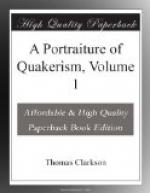Thus after having wasted a considerable portion of his time, he is driven at last by positive experience into the truth of those maxims, which philosophy and religion have established, and in the pursuit of which alone he now sees that true happiness is to be found. Thus, in consequence of his education, he looses two thirds of his time in tedious and unprofitable, if not in baneful pursuits. The young Quaker, on the other hand, comes, by means of his education, to the same maxims of philosophy and religion, as the foundation of his happiness, at a very early period of life, and therefore saves the time, and preserves the constitution which the other has been wasting for want of this early knowledge. I know of no fact more striking, or more true in the Quaker-history, than this, namely, that the young Quaker, who is educated as a Quaker, gets such a knowledge of human nature, and of the paths to wisdom and happiness, at an early age, that, though he is known to be a young mariner by the youth displayed in his countenance, he is enabled to conduct his bark through the dangerous rocks and shoals of life, with greater safety than many others, who have been longer on the ocean of this probationary world.
I may observe again, as the second fact, that it is not unusual to hear persons say, that you seldom see a disorderly Quaker, or, that a Quaker-prostitute or a Quaker criminal is unknown. These declarations, frequently and openly made, shew at least that there is an opinion among the world at large, that the Quakers are a moral people.
The mention of this last fact leads me to the notice, and the correction, of an error, which I have found to have been taken up by individuals. It is said by these that the Quakers are very wary with respect to their disorderly members, for that when any of them behave ill, they are expelled the society in order to rescue it from the disgrace of a bad character. Thus if a Quaker woman were discovered to be a prostitute, or a Quaker man to be taken up for a criminal offence, no disgrace could attach to this society as it would to others; for if, in the course of a week, after a discovery had been made of their several offences, any person were to state that two Quaker members had become infamous, it would be retorted upon him, that they were not members of the society.
It will be proper to observe upon the subject of this error, that it is not so probable that the Quakers would disown these, after the discovery of their infamy, to get rid of any stain upon the character of the society, as it is that these persons, long before the facts could be known, had been both admonished and disowned. For there is great truth in the old maxim “Nemo fecit repente ’turpissimus;” or “no man was ever all at once a rogue.”




